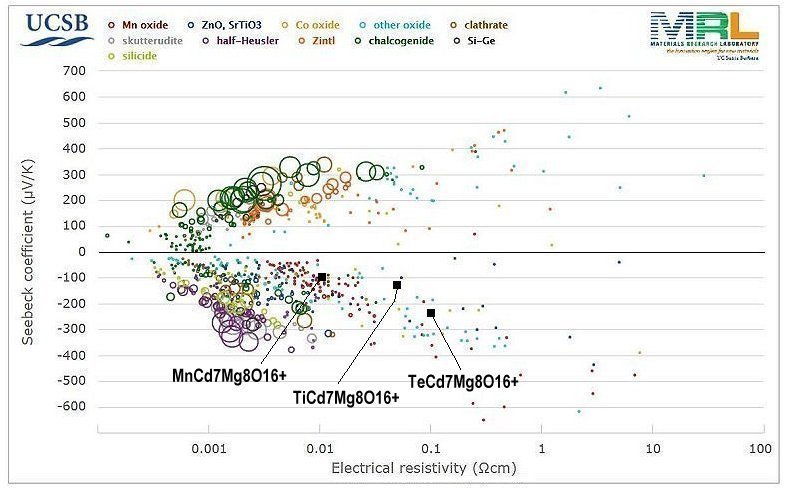

Materials scientists, it seems, are always clamoring for new thermoelectric (TE) materials, especially oxides, "currently considered to have the most potential of all thermoelectric materials".[1] Now, two high-temperature superconductors have led to the discovery of a new family of thermoelectric oxides: the N-type "178" perovskites. The "178" naming scheme comes from the stoichiometry. There is one tetravalent metal atom, 7 atoms of a divalent metal, and 8 atoms of a complementary divalent metal. And of course oxygen. In the copper-oxides these form as a collinear tetragonal structure, as shown below left. Although perovskite superconductors (YBCO, BSCCO, etc.) are already well-known thermoelectrics above their respective transition temperatures, the "178" materials appear to have unique TE properties as a sub-group within this family.
In 2013 and 2014 the compounds TaBa7Cu8O16+ and TeBa7Cu8O16+ were both found to produce a small superconductivity signature near 255 Kelvin. But when titanium was substituted into the Ta/Te atomic site, something unexpected appeared. A magnetometer persistently showed magnetic jumps as the heat gun was turned on and off. And this was the case at every temperature. These "magnetic moments", it turns out, were a product of an internal current surge being generated by the Seebeck effect. A heat gradient across the test pellet was generating voltage that was then being converted to current by the electrical resistance within the pellet. And where current flows, there is magnetism.
The Seebeck effect would seem incompatible with superconductivity - particularly when the superconductor is nearly pure and its internal resistance is zero ohms. But the compounds TaBa7Cu8O16+ and TeBa7Cu8O16+ are not structurally homogeneous. Their superconductor volume fraction (VF) is less than one percent of the bulk. So, when titanium is substituted into the tantalum or tellurium atomic site, voltage can appear across the non-superconductive bulk. The magnetic field being generated was on the order of 300 milligauss. That equates to a current flow of around 0.1 nanoamp. Not much. But enough to suggest thermoelectricity was at work.
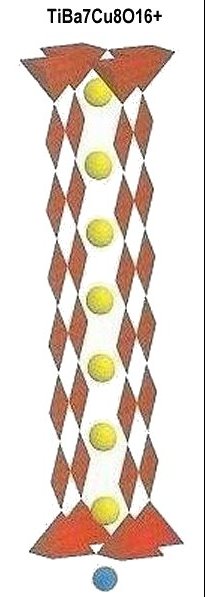
|
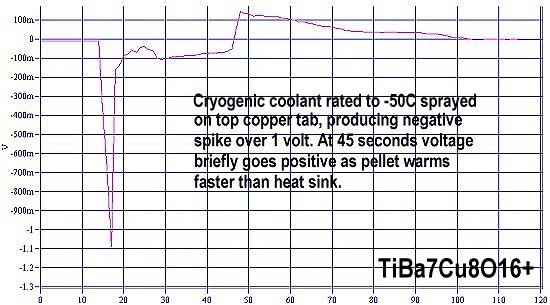
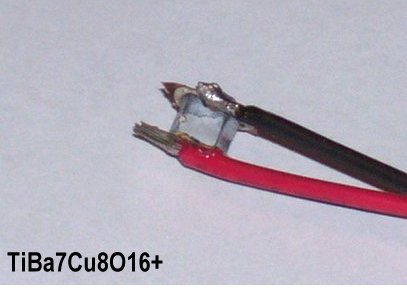
Direct thermal tests of TiBa7Cu8O16+ showed a very strong Seebeck voltage. In the above left plot over one volt appears as the material is cooled from room temperature to -50C. The fact that -50C is below the superconductive transition temperature (0 C) of the minority phase, may help explain the amplitude of the voltage surge. The Seebeck Effect and low-VF Cooper-pairing may be complementary phenomena. The nominal Seebeck voltage of this same material is only 2.5% as strong as the surge voltage. That much of a thermopower difference can only be explained by the superconductivity component that exists below 0 C. To read more about this, CLICK HERE. 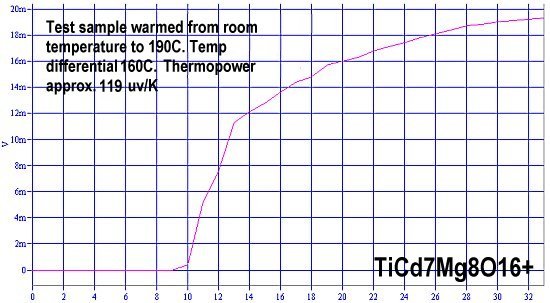
|
Synthesis of the "178" materials was by the solid state reaction method. Stoichiometric amounts of the below precursors were mixed, pelletized, and then sintered for 10+ hours at 870C. After sintering the pellet was annealed for another 10 hours at 500C in flowing O2.
TeO2 99.99% (Alfa Aesar)E. Joe Eck
© 2017 Superconductors.ORG
All rights reserved.
1. Lassi Karvonen, Petr Tome, Anke Weidenkaff, Laboratory for Solid State Chemistry and Catalysi, EMPA-Swiss Federal Laboratories for Materials Science and Technology, Dübendorf, Switzerland.
 BACK to "News" page at Superconductors.ORG
BACK to "News" page at Superconductors.ORG